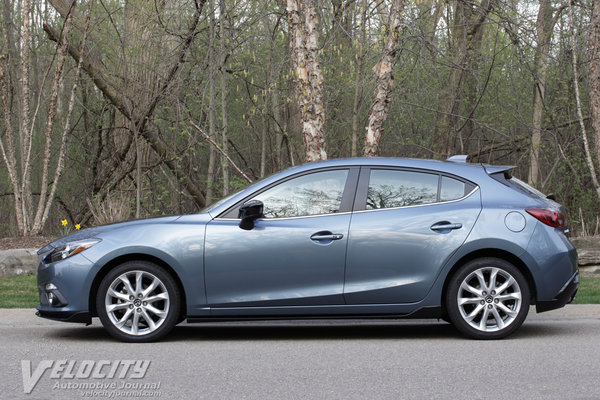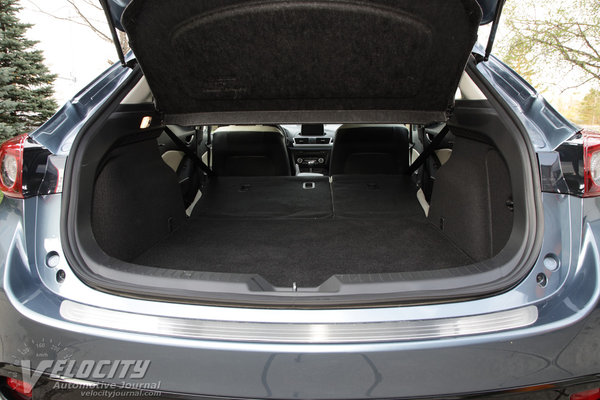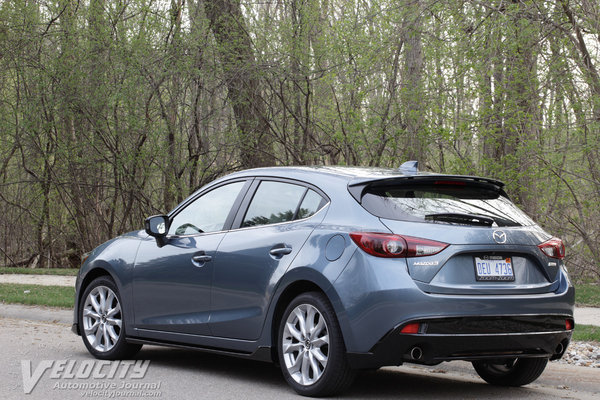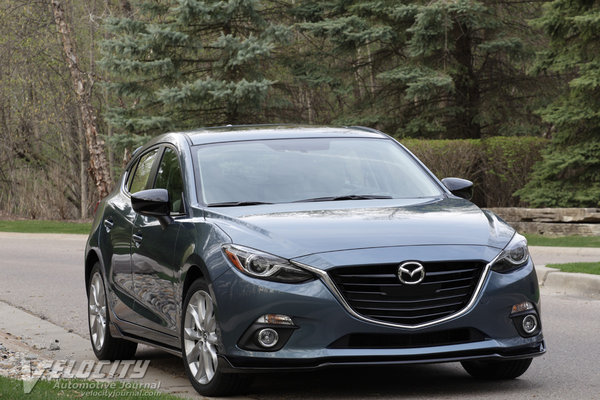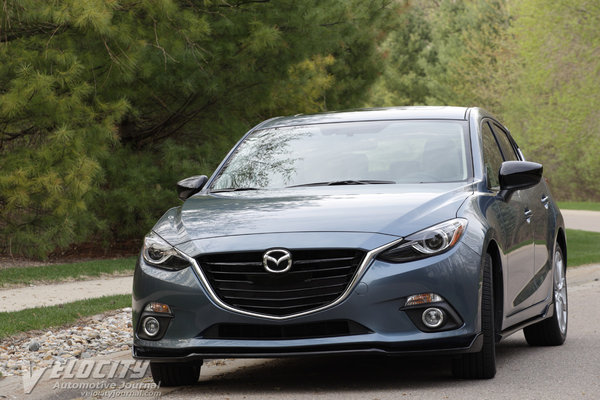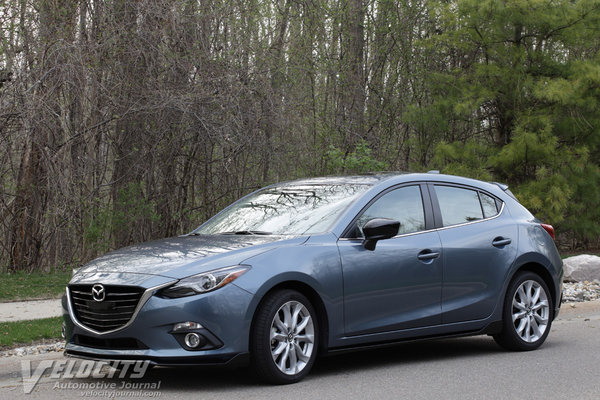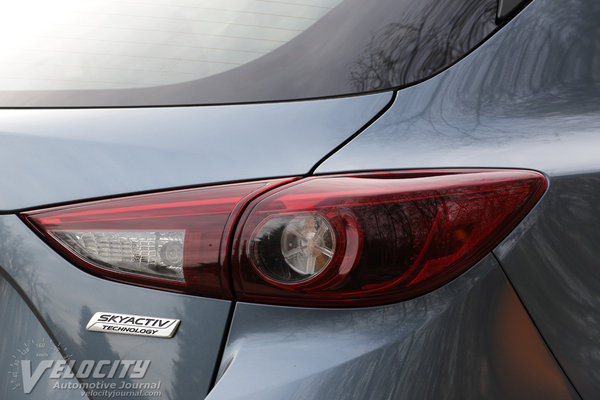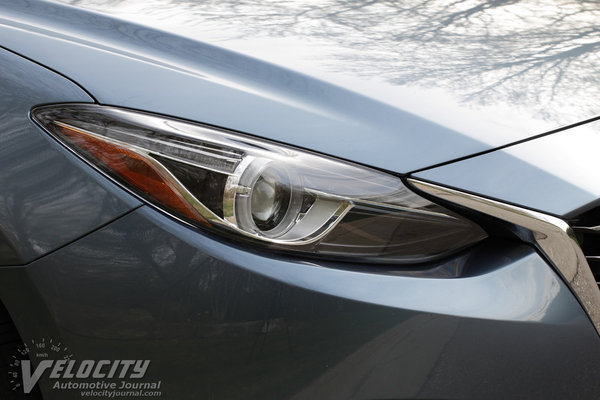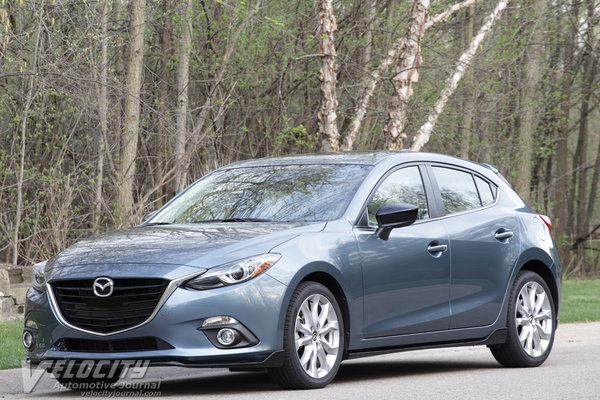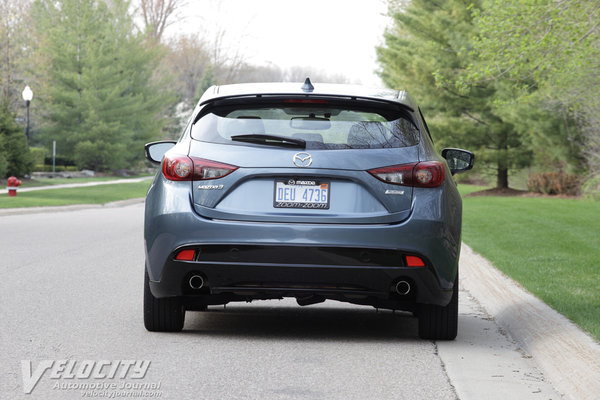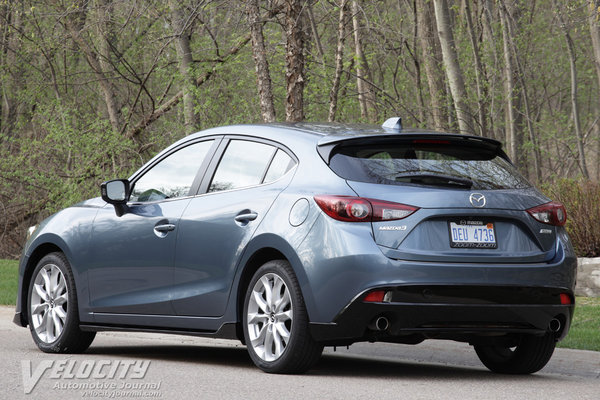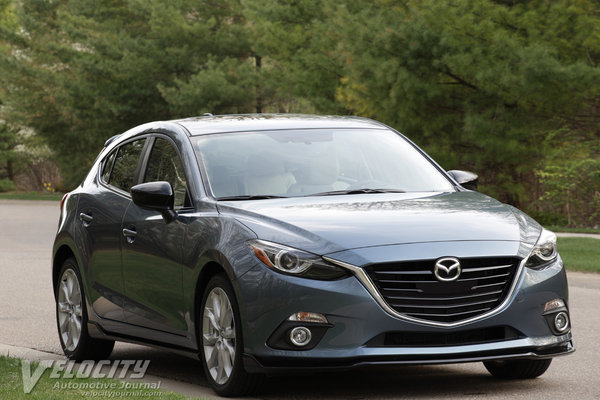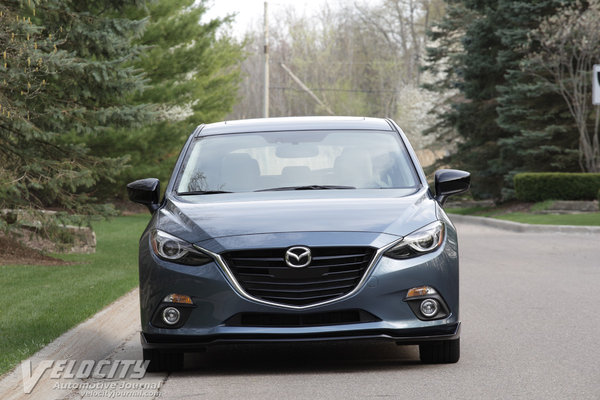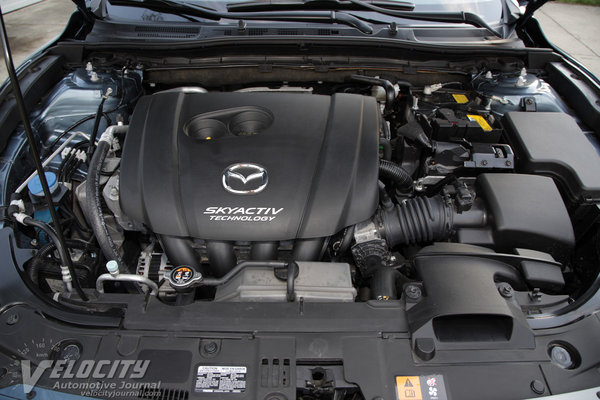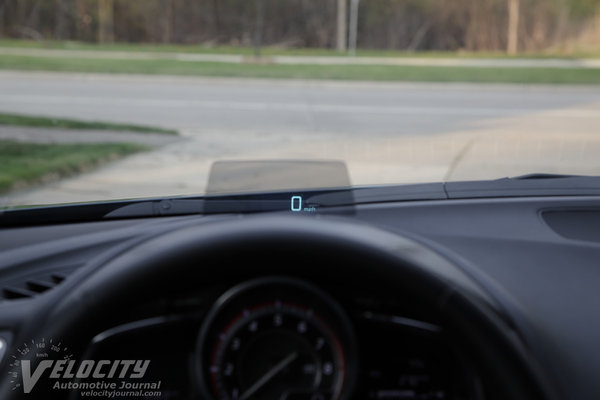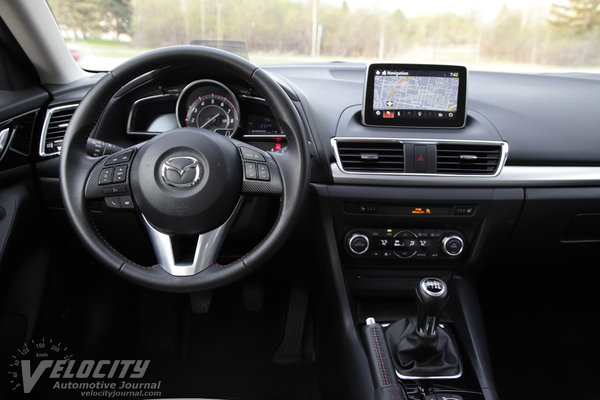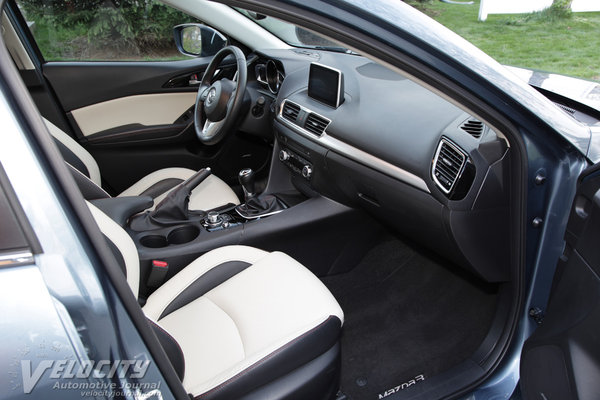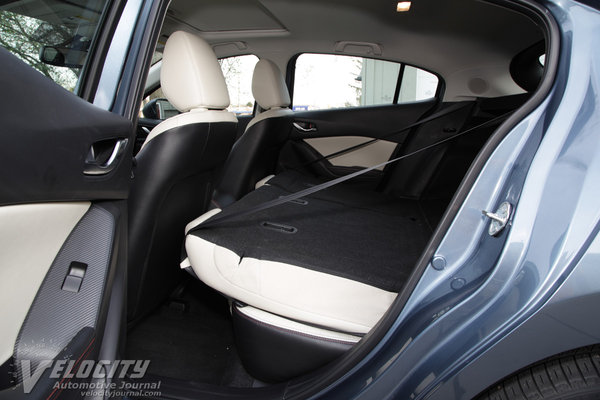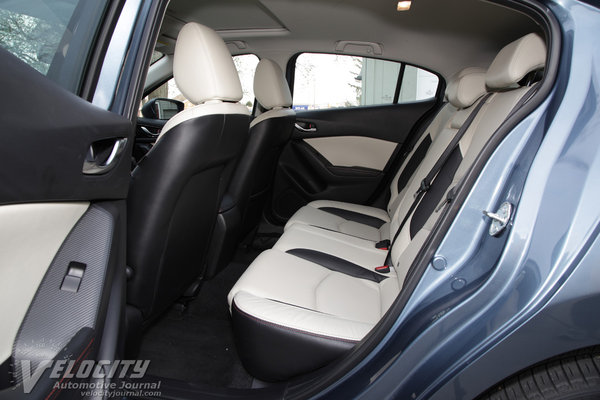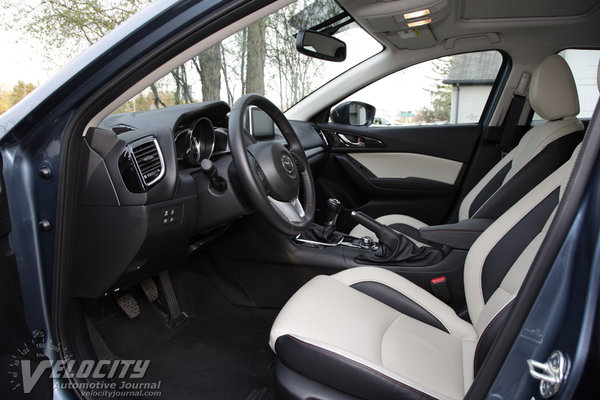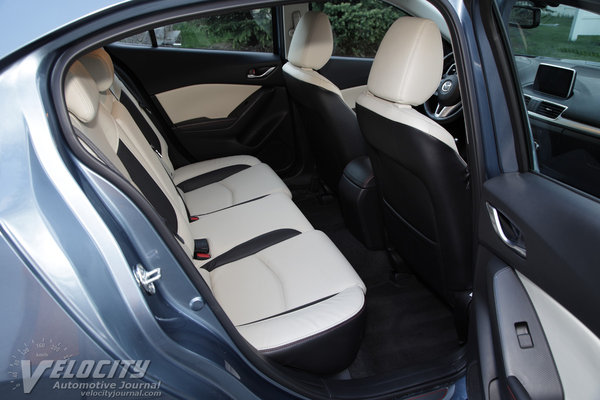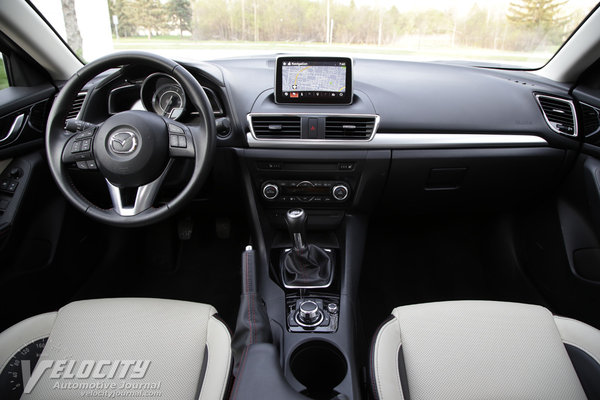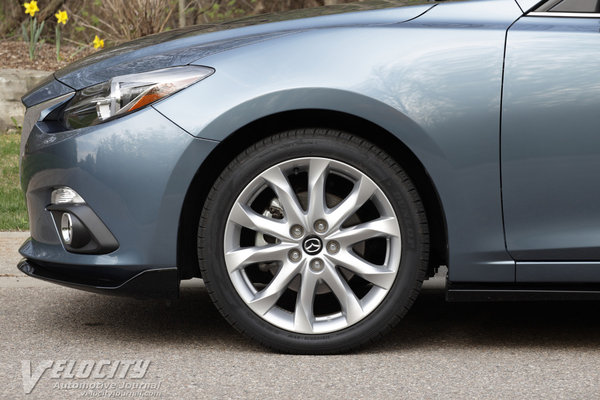2015 Mazda Mazda3s Grand Touring
06/30/2015
Shahed Hussain
Among the many compact hatchbacks available, only a few cater to enthusiasts. The Mazda3 is among the few compacts that still offer a choice of automatic or manual gearboxes, along with a comprehensive option list that allows greater customization than most of its competition. Instead of taking on the popular Corolla and Civic, Mazda seems content with a smaller slice of the market. Yet the importance of the Mazda3 is undeniable: 54% of Mazda's passenger car sales came from this compact sedan and hatchback.
Mazda wisely offers a Mazda3 model for nearly every potential customer. The 4-door sedan, available in six trim levels, is positioned as the entry model in the lineup. Its base price starts at $16,495 for the Mazda3 i SV and climbs to $25,045 for the s Grand Touring. The hatchback is available in five trim levels, starting with the base i Sport ($18,495) and ranging up to the s Grand Touring ($26,495), which we tested. Two engines are offered: a 155-bhp 2.0L or 184-bhp 2.5L inline-4 (s Touring and s Grand Touring models). All models can be paired with a choice of a 6-speed manual or optional automatic transmission.
Our test vehicle was equipped only a few options, the most expensive being the Appearance Package ($1,750) which includes an air dam, bumper skirt, rear spoiler and side sill extensions. Other minor additions were a cargo mat ($70), rear bumper guard ($100), scuff plate/door sill trim plates ($125). The total sticker price added up to a substantial $28,385 including the $795 delivery fee. The Appearance Package is attractive, but add minimal value considering its sizable cost. Among the comprehensive standard features are satellite navigation, heated leather seats, 18-inch diameter alloy wheels, adaptive bi-xenon headlights, blind spot monitoring, rear cross-traffic alert, moonroof, and a Bose audio system.
Mazda designed the interior with premium materials throughout. Examples include the matte aluminum spanning the dashboard, aluminum-rimmed control knobs, vent bezels and door handles. Glossy piano black door and center console panels contrast with the aluminum details. The heavily bolstered front seats are upholstered in almond and dark grey perforated leather. Seat heater buttons are readily accessible on the center stack above the climate controls. A touchscreen display atop the dash shows audio data and navigation maps. The touchscreen is disabled when driving, so we used the multi-function knob on the center console to adjust infotainment system settings. Adjacent is a smaller audio volume knob. The sculpted leather-wrapped steering wheel includes audio, mobile phone, and cruise control buttons. A center-mounted analog tachometer includes a digital speedometer. A retractable head-up display on the dash shows vehicle speed and navigation directions. Flanking the tachometer is the trip computer display showing fuel consumption and other vehicle data. Like other Mazdas, a coolant gauge is conspicuously missing, instead a blue light indicates cold coolant. After the engine warms up, the coolant light turns off.
Like many other compact front-drive cars, the Mazda3 uses a MacPherson strut front and multilink rear suspension with coil springs and dampers. Stabilizer bars are at both ends. The braking system consists of vented 11.61 in. diameter front discs and 10.43 in. diameter solid rear discs with power assist. ABS, traction control and Dynamic Stability Control are standard. Dunlop SP Sport 5000 215/45R18 all-season tires mounted on 18-inch diameter alloy wheels are standard for the "s" variant. Mazda3 i models are equipped with 16-inch diameter wheels and 205/60R16 all-season tires. The rack-and-pinion system is electrically-assisted with 2.57 turns lock-to-lock. Curb weight ranges from 2,854 lbs. (4 door/manual transmission) to 3,016 lbs. (5-door/automatic transmission). The 5-door test vehicle curb weight is specified as 2,978 lbs.
The dual overhead-cam 2.5L Skyactiv-G engine is rated at 184-bhp @ 5,700 RPM and 185 lb.-ft. @ 3,250 RPM. This all-aluminum alloy inline-4 is equipped direct fuel injection and variable valve-timing. Redline is a fairly conservative 6,500 RPM. The 6-speed manual has overdrive ratios for both fifth (0.837:1) and sixth (0.599:1), coupled to a 3.591:1 axle ratio. EPA fuel consumption is 26/35 MPG (city/hwy.) for the 2.5L/manual transmission combination. Choosing the 6-speed automatic with the optional i-ELOOP energy recovery system boosts fuel efficiency to 28/39 MPG (city/hwy.). The smaller 2.0L Skyactiv-G is rated at 30/40 MPG (city/hwy.) when equipped with the 6-speed automatic. Keeping the manual gearbox drops city fuel consumption to 29 MPG. With our manual transmission test vehicle, we averaged 26-27 MPG in mixed urban and highway driving. Top speed for all models is limited to 130 MPH.
Many enthusiasts will agree that comfortable, supportive seats are often missing from many affordable compact cars. Mazda understands this, so the front seats are designed for excellent support and bolstering. The driver benefits from 6-way power seats and manual lumbar adjustment, but the passenger seat only has 4-way manual controls. Rear seat passengers are rewarded with comfortable accommodations; the sculpted cushions provide above average support for the outboard occupants. The center seating position is only tolerable for short trips. Rear legroom and headroom is adequate assuming occupants are less than 6 ft. tall. The high rear beltline and short rear window gives either a cocooning or claustrophobic impression.
Given a choice between the 155-bhp 2.0L and the optional 184-bhp 2.5L, it's natural to prefer the larger displacement engine, especially with the heavier hatchback variant. On startup, the inline-4 buzzes but soon settles down to a nearly silent idle. Torque output is adequate around 2,000 RPM, but fattens considerably near the 3,250 RPM torque peak. Even below 2,000 RPM, the inline-4 pulls slowly but smoothly in fourth gear, demonstrating the flexibility of modern fuel-injected engines. Horsepower builds linearly to the 5,700 RPM peak and then falls off rapidly as revs climb to the 6,500 RPM redline. Mazda's powertrain engineers have obviously devoted much development time damping out the vibrations typical for big inline-4 engines. As a result, the 2.5L four avoids the high-RPM harshness that seems to be norm among most engines in its class. However, the long-stroke four doesn't encourage high revs and it's unnecessary to venture past 4,000 RPM to achieve decent acceleration.
The six speed manual reminded us of the joys of a properly designed gearbox. The shift lever slipped in to each gear with minimal effort. A progressively engaging clutch allowed graceful takeoff from a standstill without any annoying shudders in the driveline. A digital display on the gauge cluster indicates the selected gear and shows an upshift "arrow" to encourage minimal fuel consumption. Gear ratios are also optimized for fuel efficiency: both fifth (0.837:1) and sixth (0.680:1) are overdrive, coupled to a 3.85:1 axle ratio. The 6-speed automatic has even taller sixth gear (0.599:1) and a 3.389:1 axle ratio, which leads to its higher EPA fuel economy rating.
We expected sporty handling, but the Mazda3 delivered mixed results. Minimal understeer combined with moderate body roll proved to be an engaging mix, but the Dunlop SP5000 tires had unimpressive grip in both dry and wet weather. A glance at the tire sidewall showed a "B" wet traction rating, explaining its mediocre grip. Despite spring rates optimized for a compliant ride, the stiff sidewalls of the 45-series Dunlops could not absorb impacts from frost heaves and patched pavement. Customers in other regions with properly maintained roads may not notice. Opting for the 16-inch diameter wheels and 6-series tires on the Mazda3 i will likely enhance ride comfort, but sacrifice some steering turn-in response. Braking performance is adequate, aided by a progressive pedal, but the soft spring rates resulted in noticeable dive under braking. The electrically-assisted steering is tuned for moderate effort and provide decent feedback of road surfaces. On the highway, wind noise is subdued, but significant tire hiss penetrate the passenger compartment, especially on some asphalt surfaces. The chassis handles most bumps with ease, but the previously mentioned frost heaves tend to upset directional stability.
Mazda has marketed itself as a driver-oriented brand, so it would be disappointing to report that the Mazda3 is not aimed at enthusiasts. Fortunately, this is not the case, as the Mazda3 has most of the details right. A few of its suspension deficiencies could be readily corrected. However, the most significant issue with the Mazda3s Grand Touring is its pricing. We think that shoppers with $28K to spend will likely prefer the larger Mazda6. But opting for the less extravagant trim "i Touring" or "s Touring" models slices thousands off the sticker price, making the Mazda3 a sensible choice for the practical driving enthusiast.

